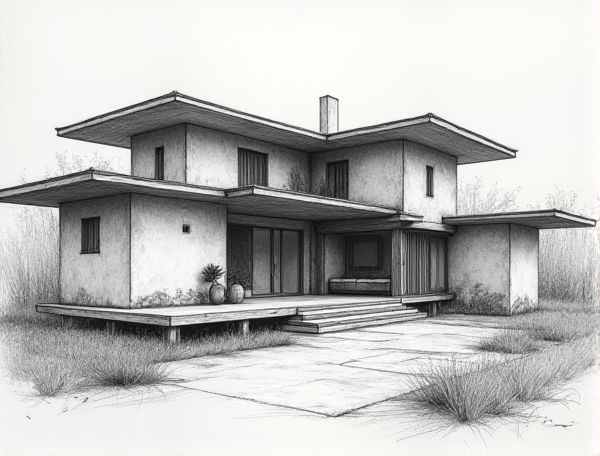
Photo illustration: Wabi-sabi home design with weathered plaster walls
Embrace the natural beauty of imperfection with Wabi-sabi home design, where weathered plaster walls add texture and a timeless, rustic charm to your living space. Discover how to incorporate these atmospheric elements and create a serene environment by reading more in the article.
Embracing Wabi-Sabi: The Art of Imperfection in Home Design
Wabi-Sabi celebrates the beauty of imperfection and natural materials, highlighting rustic wood textures, muted earth tones, and handcrafted decor to create a serene and authentic home environment. By embracing this philosophy, your living space reflects simplicity and tranquility, fostering a unique aesthetic that values impermanence and imperfection.
Why Weathered Plaster Walls Define Authentic Wabi-Sabi Aesthetics
Weathered plaster walls embody the Wabi-Sabi aesthetic by celebrating imperfection and natural aging through their textured surfaces and subtle color variations. Your home gains a unique, tranquil character that honors simplicity and the beauty of transience inherent in this Japanese design philosophy.
Colors and Textures: Creating Depth with Aged Plaster Finishes
Aged plaster finishes introduce rich textures and subtle color variations that enhance the depth and character of interior walls. This design technique mimics natural weathering, incorporating earthy tones and soft gradients that bring warmth and authenticity to living spaces. Combining these tactile surfaces with complementary furniture and lighting amplifies the room's dimensionality and visual appeal.
Layered History: The Story Behind Weathered Plaster Surfaces
Weathered plaster surfaces reveal a layered history of a home's evolution, capturing decades of design trends, repairs, and environmental changes. Each crack, patina, and texture variation narrates the story of material aging and craftsmanship techniques unique to specific architectural periods. Embracing these imperfections adds character and depth, transforming walls into living records of historic ambiance and artisanal heritage.
Materials That Complement Wabi-Sabi Weathered Walls
Natural materials such as reclaimed wood, linen textiles, and unglazed ceramics enhance the organic texture and imperfect beauty of wabi-sabi weathered walls, emphasizing authenticity and simplicity. Incorporating elements like rusted metal accents and stone surfaces creates a harmonious balance that highlights the worn, textured character intrinsic to wabi-sabi design.
Minimalism Meets Warmth: Furnishing a Wabi-Sabi Plaster Interior
Wabi-Sabi plaster interiors embody minimalism through their organic textures and earthy tones, creating a space where imperfection and simplicity converge with warmth. Furnishing these interiors with natural wood, soft textiles, and handcrafted decor enhances the serene ambiance while celebrating the beauty of imperfection inherent in Wabi-Sabi design.
Natural Lighting and Atmosphere in Wabi-Sabi Spaces
Natural lighting enhances the serene atmosphere of Wabi-Sabi spaces by emphasizing organic textures and muted color palettes found in handcrafted materials. Your home design can incorporate large windows, skylights, and strategically placed openings to maximize the gentle flow of daylight, creating a balanced interplay between light and shadow. This approach not only highlights imperfections but also fosters a tranquil, authentic environment that aligns with the core principles of Wabi-Sabi aesthetics.
Maintenance and Care for Weathered Plaster Walls
Regular inspection and timely sealing of cracks in weathered plaster walls prevent moisture infiltration and structural damage. Using breathable, weather-resistant coatings and applying gentle cleaning techniques extend the longevity and aesthetic appeal of plaster surfaces.
DIY Tips for Achieving the Wabi-Sabi Plaster Look
Achieving the Wabi-Sabi plaster look at home requires embracing natural imperfections and using organic materials like clay or lime plaster for authentic texture. Applying plaster unevenly with trowels or sponges enhances the rustic, imperfect aesthetic central to Wabi-Sabi design. Sealing the surface with natural wax or oil maintains the tactile quality while protecting the finish for long-lasting beauty.
Inspirational Wabi-Sabi Interiors: Real-World Examples
Wabi-Sabi interiors embrace imperfection and natural materials, featuring weathered wood, muted earth tones, and handcrafted ceramics that create a tranquil, authentic atmosphere. Real-world examples showcase minimalist layouts with asymmetrical elements, organic textures, and vintage decor, illustrating the beauty found in simplicity and the passage of time.
 homedesy.com
homedesy.com